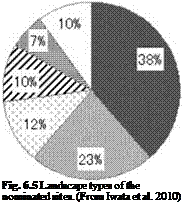6.3.1 “The Top 100 Japanese Rural Landscapes”
and Its Previous Research
In 2008, Asahi Shimbun Newspaper Company, one of the biggest newspaper companies in Japan, conducted “The Top 100 Japanese Rural Landscapes” contest to select the 100 best Japanese rural landscapes through a system of public nominations. The question asked was “which is your favorite rural landscape, and why?,” and people wrote the name of a place and the reasons for its selection in an open answer. The criteria are landscape, biodiversity, and human activities (Forests Culture Association 2009).
Consequently, 3,022 sites were nominated, which were assigned longitude and latitude values (Iwata et al. 2010). Combined with geographic data such as land use (National Land Information Office 1997), mean altitude (National Land Information Office 1981), and height range (National Land Information Office 1981), Iwata et al. (2010) classified the nominated sites into six landscape types using nonhierarchical cluster analysis. Also, keywords that appeared more than 100 times in all the nomination forms were extracted using SPSS Text Analysis for Surveys 3.0 Japanese (SPSS Inc. 2007), and the relationship with the landscape types was examined using cross analysis (x2 test; SPSS Inc. 16.0 Japanese 2007).
The results (shown in Fig. 6.5 and Table 6.2) showed that the majority of the nominated sites were categorized as forest type (88 % forest cover in 1 km2). The most closely correlated keywords were “landscape,” “beauty,” “traditional culture,” and “history.” The next most popular rural landscapes were categorized as mixed type (60 % forest, 20 % paddy fields in 1 km2). The keywords correlated were “biodiversity” and “preservation activities.” Paddy field type sites (paddy field >60 % in 1 km2) were significantly associated with the word “Furusato (home),” and urban and suburban type sites (built-up land, 50 %) were concentrated in the Kanto Region, and they were nominated mainly by local citizens for their nature activities (Iwata et al. 2010).
Forest

![]() Mixed
Mixed
Paddy Field
Other Agricultural
Urban & Sububan
Coastal
|
Table 6.2 Landscape types and their characteristics and keywords than appeared frequently in each landscape type
Source: Iwata et al. (2010) Correlation with confidence with 1% (marked as **) and 5% (marked as *) |



